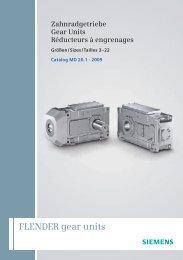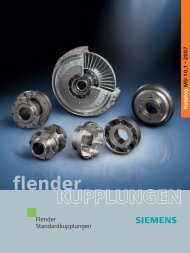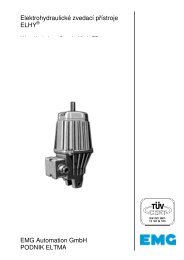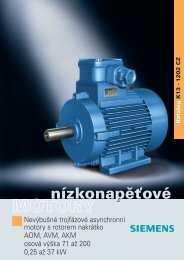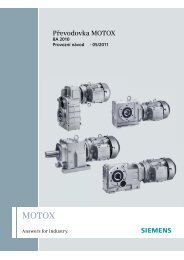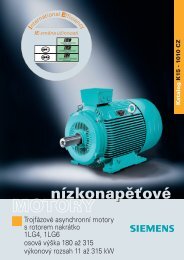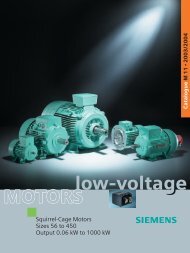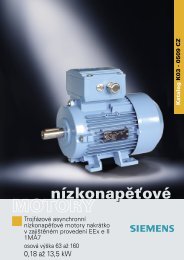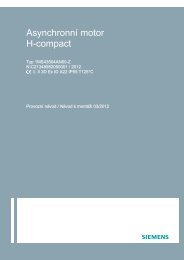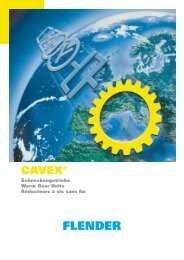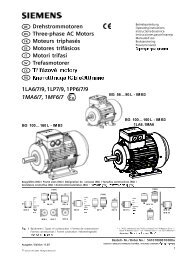Drehstrommotoren 1LG4 1LG6 - MOTOR-GEAR as
Drehstrommotoren 1LG4 1LG6 - MOTOR-GEAR as
Drehstrommotoren 1LG4 1LG6 - MOTOR-GEAR as
Create successful ePaper yourself
Turn your PDF publications into a flip-book with our unique Google optimized e-Paper software.
DEUTSCH / ENGLISH / FRANÇAIS / ESPAŇOL / ITALIANO / SVENSKA / ČESKY / ПО РУССКИ / NEDERLANDS<br />
General note<br />
The data and recommendations<br />
WARNING<br />
specified in all the instructions<br />
supplied, and in all other related instructions, must always<br />
be observed in order to avoid hazardous situations and<br />
the risk of possible injury or damage.<br />
These instructions are augmented by supplementary<br />
instructions (yellow), which contain additional information<br />
on the safety me<strong>as</strong>ures for electrical machines and<br />
devices. The latter instructions thus augment all submitted<br />
instructions and all other related instructions.<br />
Furthermore, the pertinent national, local and plantspecific<br />
regulations and requirements should be kept<br />
in mind!<br />
Special designs and other versions may vary in<br />
technical details! If in doubt, be sure to contact the<br />
manufacturer, quoting the type designation and serial<br />
number, or have maintenance work done by one of<br />
SIEMENS Service Centres.<br />
NOTE: Fig. 2 ... (Spare Parts) see Annex page 35-36<br />
1 Description<br />
1.1 Application<br />
The motors are suitable for operation in dusty and damp<br />
environments. The insulation is tropicalized. If they are<br />
properly stored or installed outdoors, special weatherproofing<br />
me<strong>as</strong>ures are not usually required.<br />
Me<strong>as</strong>uring-surface sound-pressure level at 50 Hz<br />
(DIN EN 21 680 Part 1)<br />
<strong>1LG4</strong>, <strong>1LG6</strong> approx. 51 to 76 dB(A)<br />
1.2 Construction and mode of operation<br />
The <strong>1LG4</strong> and <strong>1LG6</strong> motors are standardly self-ventilated with<br />
own fans. In addition to that the 1LG motors are optionally<br />
either without an own fan (such <strong>as</strong> fan motors with cooling by<br />
means of a separate fan arranged on the shaft end) or with<br />
external coolling (option G17). The 1PP4 and 1PP6 motors<br />
are equipped with own cooling without any fan.<br />
The feet on foot-mounted motors are c<strong>as</strong>t integrally with the<br />
motor c<strong>as</strong>ing or they can be optionally bolted onto the c<strong>as</strong>ing<br />
(option K11 / see fig. 2).<br />
Rearranging the feet (e.g. for changing the position of the<br />
terminal box) is possible for options K09, K10 and K11. The<br />
bores and surfaces, necessary for this purpose, are already<br />
machined in a corresponding way.<br />
Where motors with brake are concerned (e.g. option G26),<br />
take into consideration also the brake operating instructions!<br />
These instructions are valid in addition to the operating<br />
instructions of the given motor type. They are not valid for<br />
motors of EEx e series.<br />
2 Operation<br />
Before starting any work on the<br />
WARNING<br />
2.1 Transport, storage<br />
machine, be sure to isolate it from<br />
the power supply.<br />
The motors should always be lifted at both lifting eyes during<br />
transport.<br />
For lifting machine sets (such <strong>as</strong> built-on gearboxes, fan<br />
units), always use the lifting eyes or<br />
WARNING<br />
lifting pegs provided! Machine sets<br />
may not be lifted by suspending the<br />
individual machines! Check the lifting capacity of the<br />
hoist!<br />
If, after delivery, the motors are stored for more than 3 years<br />
under favourable conditions (kept in a dry place free from dust<br />
and vibration) prior to commissioning, the bearings should be<br />
regre<strong>as</strong>ed respectively exchanged.<br />
Under unfavourable conditions, this period is considerably<br />
shorter.<br />
If necessary, the insulation resistance of the winding should<br />
be checked, see Section 2.5.<br />
2.2 Installation<br />
After installation, screwed-in lifting eyes should either be<br />
removed or tightened down.<br />
In the c<strong>as</strong>e of motors with shaft end facing upwards or<br />
downwards, me<strong>as</strong>ures must be taken to ensure that no water<br />
can penetrate into the upper bearing.<br />
In the c<strong>as</strong>e of terminal boards with 6 terminals, the top part<br />
of the terminal box can be turned through 4 x 90 degrees. For<br />
terminal boards with 9 terminals, it can be turned through 180<br />
degrees.<br />
Quiet running<br />
Stable foundations or mounting conditions, exact alignment of<br />
the motors and a well-balanced transmission element are<br />
essential for quiet vibration-free running. Before starting an<br />
<strong>as</strong>sembly, the contact surfaces for engine <strong>as</strong>sembly should be<br />
cleaned and checked for flatness. To avoid stress in the<br />
engine feet, the total flatness of the contact surfaces of the<br />
b<strong>as</strong>e should not exceed 0.2 mm. The contact surfaces to be<br />
welded should be smoothed by grinding to reach the flatness<br />
required. If sheets are used for padding to set an elevation<br />
and avoid stress in the engine, they should be made from<br />
rolled stock of an appropriate size. It may also be necessary<br />
to balance the rotor with transfer element.<br />
2.3 Balancing, transmission elements<br />
A suitable device should always be used for fitting and<br />
removing the transmission elements (coupling halves, pulleys,<br />
pinions) (Fig. 7).<br />
As standard, the rotors are dynamically balanced with the<br />
half featherkey inserted.<br />
The type of balance is marked on the drive end of the shaft<br />
(shaft end face):<br />
(H = balanced with half featherkey)<br />
(F = balanced with whole featherkey)<br />
When fitting the transmission element, keep the type of<br />
balance in mind!<br />
Balance with half featherkey<br />
Poor running characteristics can arise in the c<strong>as</strong>e of<br />
transmission elements having a length ratio of hub length l to<br />
length of shaft end l < 0.8 and running at speeds of > 1500<br />
M<br />
rev/min (see Fig. 8). If necessary, re-balancing should be<br />
carried out, e.g. the part of the featherkey T that protrudes<br />
p<br />
from the transmission element and above the shaft surface<br />
should be cut back.<br />
The usual me<strong>as</strong>ures should be taken<br />
WARNING<br />
to guard transmission elements from<br />
touch. If a motor is started up without transmission<br />
element attached, the featherkey should be secured to<br />
prevent it being thrown out.<br />
Edition N14-0903 Bestell-Nr. / Order No. 35037000000057<br />
© Siemens AG 2000 All Rights Reserved DEUTSCH/ENGLISH/FRANCAIS/ESPANNOL/ITALIANO/SVENSKA/ČESKY/ПО РУССКИ/NEDERLANDS<br />
Siemens AG<br />
5



